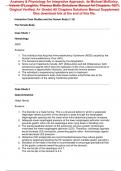Interactive Case Studies and the Huma n Body (1 -10) The Female Body Case Study 1 Hematology AIDS Answers: 1.This individual has Acquired Immunodeficiency Syndrome (AIDS) caused by the
Human Immunodeficiency Virus (HIV).
2.The hematocrit abnormality is cause d by the dehydration.
3.Some current treatments include: AZT (Zidovudine) and ddI (Didanosine), both
antiretroviral agents which slow the replication of the virus, prevent occurrence or
recurrence of opportunistic infections, and boost the immune system.
4.The individual is experiencing hypokalemia prior to treatment.
5.This abnormal potassium level could cause cardiac arrhythmias due to the
hyperpolarization of the resting membrane potential.
Case Study 2 Gastrointestinal Hiatal Hernia Answers: 1.The disorder is a hiatal hernia. This is a structural defect in which a weakened
diaphragm allows a portion of the stomach to pass through the esophageal
diaphragmatic opening into the chest when intra -abdominal pressure increases.
2.Adequate lower esophageal pressure at the lower esophageal sphincter normally
prevents gastric reflux into the esophagus when lying down or bending over.
3.The parasympathetic division of the autonomic nervous system (cholinergic)
innervates the lower esophageal sphincter (LES). Therefore, c holinergic agonists
would increase LES contraction, preventing gastric reflux. Anticholinergic agents
would decrease LES pressure.
4.Histamine (H2) antagonists are recommended because they reduce gastric
acidity by selectively blocking the H2 receptors (whi ch mediate gastric secretion).
5.Elevation of the head of the bed is recommended to encourage gravitational flow
of the gastric contents toward the pyloric end of the stomach.
6.The normal pH of the esophagus is 6 -7.
The normal pH of the stomach is 2 -5.Anatomy & Physiology An Integrative Approach, 4e Michael McKinley, Valerie O'Loughlin, Theresa Bidle (Solutions Manual All Chapters, 100% Original Verified, A+ Grade) All Chapters Solutions Manual Supplement files download link at the end of this file. The lower esophageal pH for this individual may be approximately 3 -5. The stomach pH would not change (pH = 2 -5). Case Study 3 Reproductive Endometriosis Answers: 1. A. This condition is known as endometriosis. B. It may be caused by (a) a retrograde flow of me nstrual tissue back through the uterine (fallopian) tubes, (b) an in situ formation from hormonally induced metaplasia, or (c) a combination of transport of tissue and metaplastic changes. 2. Ectopic endometrial tissue is endometrial tissue occurring in a pla ce other than the uterus, such as the abdominal cavity or uterine tubes. 3. Danazol, a gonadotropin inhibitor, blocks Gn -RH output to decrease FSH and LH output, thus decreasing circulating estrogen and progesterone. This will prevent endometrial growth, v ascularization, and menses, and allow the aberrant endometrial implants to regress. 4. Oral contraceptives could also be used as a treatment since they too can suppress ovarian luteal function and decrease circulating estrogen and progesterone. Case Study 4 Muscle Physiology Heat Cramps Answers: 1. A cramp within a muscle is an involuntary, painful, and prolonged contraction. The precise cause of cramping is not known but is probably due to conditions within the muscle, such as altered calcium or oxygen levels, or to stimulation of the motor neurons. 2. Carpopedal spasms are spasmodic contractions of the muscles of the hands and feet. 3. Salt and water ingestion is beneficial because NaCl and water have been lost during profuse sweating. Therefore, hypovolemia (decr eased circulating body fluid volume) is occurring. This is causing blood to be redistributed to the vital organs of the body (brain, heart, lungs) and directed away from exercising skeletal muscle. The skeletal muscle is therefore exposed to low oxygen and increased waste metabolites (lactic acid, etc.). This causes the severe cramping. Body fluids are isotonic to a 0.9% NaCl solution. Since NaCl and water have both been lost during sweating, replacement of both is essential to restore the blood volume back to normal. (In individuals who become unconscious during heat shock, intravenous infusions of 0.9% NaCl are administered.) Case Study 5 Muscle Physiology Neuromuscular Blocking Agents (for Surgery) Answers: 1. The depolarizing impulse releases acetylcholin e (ACh) from the nerve ending, which diffuses across the neuromuscular junction. At the muscle membrane or motor end -plate, the ACh attaches to its specific receptor sites. The ionic channels (primarily sodium) open, allowing the ions to cross the membrane . If a sufficient quantity of the neurotransmitter is released and threshold is reached, action potentials will be elicited. This electrical activity will cause the release of calcium from the terminal cisternae. The calcium will interact with the contract ile proteins (troponin) of the thin filaments, allowing tropomyosin to be moved away from the actin active sites so myosin heads can form cross -bridges with the binding sites on the actin proteins, resulting in sarcomere shortening and muscle contraction. 2. ACh is hydrolyzed by the enzyme acetylcholinesterase (AChE), which is on the postsynaptic membrane, with its active site facing the synaptic cleft. 3. Agents or drugs that block or compete for the ACh receptors themselves will prevent the normal interaction of the transmitter and the receptors, thus blocking muscle contraction and causing flaccid paralysis. (Curare competes with ACh for the receptor proteins on the muscle cell membrane, thus reducing the size of the end-plate potential. Thus, curare can be u sed as a muscle relaxant during anesthesia.)




